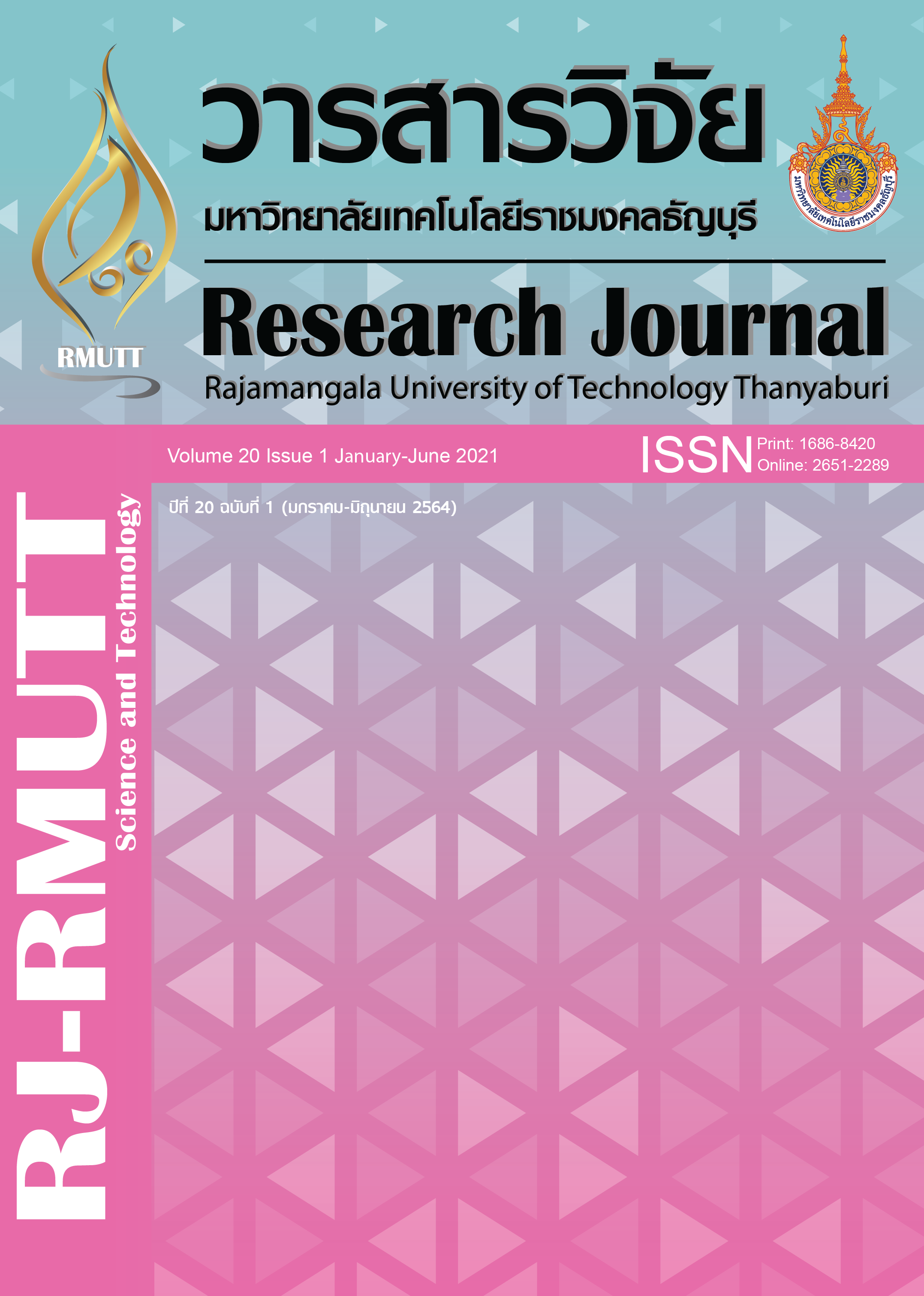In Vitro Self and Cross Pollinated Seed Culture of Nymphaea rubra ‘Maeploi’, A Night – Blooming Tropical Waterlily Hybrid (Nymphaeaceae) from Thailand
Main Article Content
Abstract
This research was aimed to develop culture medium enhancing the germination of self and cross-pollinated seeds in Nymphaea rubra ‘Maeploi’ and Nymphaea pubescens Willd. The self-pollinated seeds of N. rubra ‘Maeploi’ were investigated for surface sterilization method, seed culture medium and light conditions. The self-pollinated seeds were surface sterilization with 20% (v/v) sodium hypochlorite (NaOCl) at various times (5, 10, 15 and 20 min), followed by the second surface sterilization with NaOCl at different concentrations (5, 10, 15 and 20% (v/v)) for 10 min. MS medium at different strengths (MS, 1/2MS, 1/4MS, 1/8MS) was also studied to rescue the cross-pollinated seeds, compared to control. The results showed that the fruit set percentages of N. pubescens x N. rubra ‘Maeploi’ and N. rubra ‘Maeploi’ x N. pubescens were low at 5% and 3.33%, respectively. The N. rubra ‘Maeploi’ self-pollinated seeds were soaked with 20% (v/v) NaOCl for 5 min, followed by the sterilization with 5% (v/v) NaOCl for 10 min showed without the microbial contamination. Moreover, the suitable medium for N. rubra ‘Maeploi’ self-pollinated seeds was 1/8MS semi solid medium under dark condition. The germinated seedlings were developed shoots (60%), immature leaves (51.67%), and roots (48.33%) after 4 weeks of culture. Germination percentages of N. rubra ‘Maeploi’ and N. pubescens self-pollinated seeds cultured on 1/8MS were 51.67 higher than those of cross-pollinated seeds of N. pubescens x N. rubra ‘Maeploi’ and N. rubra ‘Maeploi’ x N. pubescens (35 and 31.67%, respectively).
Article Details

This work is licensed under a Creative Commons Attribution-NonCommercial-NoDerivatives 4.0 International License.
References
Borsch T, Hilu KW, Wiersema JH, LÖhne C, Barthlott W, Wildes V. Phylogeny of Nymphaea (Nymphaeaceae): evidence from substitu-tions and microstructural changes in the chloroplast trnT-trnF Region. Int J Plant Sci 2007;168(5):639–71.
Anon. Genera of Nymphaeaceae, Germplasm Resources Information Network [Internet]. GRIN Taxonomy for Plants; 2008 [updated on 2008 Feb 17]. Availability from: www.ars-grin.gov
Songpanich P, Hongtrakul V. Intersubgeneric cross in Nymphaea spp. L. to develop a blue hardy waterlily. Sci Hortic Amsterdam. 2010;124:475-81.
Eiad-thong W. Phylogenetic relationship of the genus Nymphaea. Proceedings of Lotus park in Thai Culture. 2013 Dec 18; Office of Agricultural Museum and Culture, Kasetsart University, Bangkok, Thailand: 2013.
Pooma R. Concise Encyclopedia of Plants in Thailand, Commemorate the 60th Birthday Anniversary of Her Royal Highness Princess Maha Chakri Sirindhorn. Bangkok: The Forest Herbarium (BKF); 2016. p. 517.
Selvakumari E, Shantha S, Purushoth PT, Sreenathkumar C. Antiproliferation activity of ethanolic flower extract from Nymphaea pubescens Willd. against human cervical and breast carcinoma in vitro. International Research Journal of Pharmacy. 2012;3(1):124–5.
Wasuwat S. Ornamental Waterlilies in Thai-land. Bangkok: Nation Book Publishing; 2005. p. 192.
Murashige T, Skoog FA. Revised medium for rapid growth and bio-assays with tobacco tissue cultures. Plant Physiol. 1962;15:473-97.
Sehrawat N, Jaiwal PK, Bhat KV, Tomooka N, Kaga A, Yadav M. Breeding mediated improvement of mungbean (Vigna radiate (L.) Wilczek) for salt tolerance. Thai Journal of Agricultural Science. 2014;47(2):109-14.
Tsai MY, Chen SH, Kao WY. Floral morphs and seed production from hand-pollination in a population of Oxalis corymbosa in Taiwan. Flora. 2017;226:89-95.
Buitendijk JH, Pinsonneaux N, Donk ACV, Ramanna MS, Lammeren AAMV. Embryo rescue by half-ovule culture for the production of interspecific hybrids in Alstroemeria. Sci Hortic Amsterdam. 1995;64:65-75.
Liu H, Yan G, Sedgley R. Interspecific hybrid-ization in the genus Leucadendron through embryo rescue. S Afr J Bot. 2006;72(3):416-20.
Manzur JP, Penella C, Burruezo AR. Effect of the genotype, developmental stage and medium composition on the in vitro culture efficiency of immature zygotic embryos from genus Capsicum. Sci Hortic Amster-dam. 2013;161:181-7.
Srinives P, Tanya P, Somta P. Science in plant breeding and the importance to hu-manity. Thailand Advanced Institute of Sci-ence and Technology. 2015;1(1):46-64.
Khan S, Al-Qurainy F, Nadeem M. Biotech-nological approaches for conservation and improvement of rare and endangered plants of Saudi Arabia. Saudi J Biol Sci. 2012;19(1):1-11.
Dubranszki J, da Silva JAT. Micropropagation of apple-A review. Biotechnol Adv. 2010;28(4):462-88.
Paul S, Kumaria S, Tandon P. An effective nutrient medium for asymbiotic seed ger-mination and large-scale in vitro regenera-tion of Dendrobium hookerianum, a threat-ened orchid of northeast India. AoB Plants. 2011;2012(plr032):1-7.
Bodhipadma K, Noichinda S, Wachirabongkoth P, Pukpoomin E, Punnakanta L, Nathalang K. In Vitro Propagation of Nymphaea nouchali var. versicolor ‘Bua Phuean’. The Journal of Applied Science. 2011;10(2):7-11.
Songpanich P, Hongtrakul V. Nymphaea ‘Siam Blue Hardy’: The world’s first blue hardy waterlily. Thai Agricultural Research Journal. 2009;27(1):68-81.
Songpanich P. Hardy waterlily (Nymphaea sp.) hybridization. The Water Garden Jour-nal. 2009;24(3):10-5.
Sun C, Ma Z, Zhang Z, Sun G, Dai Z. Factors influencing cross barriers in interspecific hybridizations of water lily. J Amer Soc Hort Sci. 2018;143(2):130-5.
Sun CQ, Ma ZH, Sun GS, Dai ZL, Teng NJ, Pan YP. Cellular mechanisms of reproduc-tive barriers in some crosses of water lily (Nymphaea spp.) cultivars. Hort Science. 2015;50(1):30-5.
Kumar PP, Loh CS. Plant tissue culture for biotechnology. In: Altman A, Hasegawa PM, editor. Chapter number 9. Plant Biotech-nology and Agriculture. Prospects for the 21st Century. 1st ed. United States of Amer-ica: Academic Press; 2012. p. 586.
Ahmadi E, Nasr SMH, Jalilvand H, Savad-koohi SK. Contamination control of microbe Ziziphus spina [christti] seed in vitro cul-ture. Trees. 2012;26:1299-304.
Sawant RA, Tawar PN. Use of Sodium hypochlorite as media sterilant in sugar-cane micropropagation at commercial scale. Sugar Tech. 2011;13(1):27-35.
Noimai Y. [Effects of plant growth regulators on seed germination treatment of Nym-phaea gigantea ‘Atrans’ hybrid in vitro con-ditions]. Research Journal Rajamangala Uni-versity of Technology Thanyaburi. 2018;17(2):54-64. Thai.


